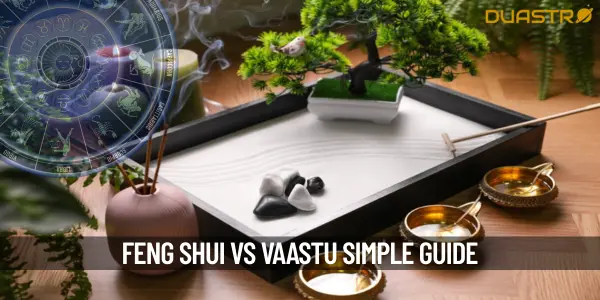What is The Difference Between Feng Shui & Vaastu
When it comes to improving energy flow in homes & bringing harmony into life two popular systems come into focus—Feng Shui & Vaastu Shastra. While both have similar goals of creating balance between human life & nature they come from different cultures use different principles & follow different methods. Many people wonder about the difference between Feng Shui & Vaastu primary when choosing which system to apply in their homes or offices. In this blog by Duastro we will explain these differences in a simple & easy-to-understand way.
What is Feng Shui?
Feng Shui is an ancient Chinese system that focuses on arranging spaces to promote positive energy or "Chi." The main goal of Feng Shui is to create harmony between people & their surroundings. Feng Shui uses elements like wind water colors shapes & directions to improve health relationships & financial luck. This is based on the five elements theory—wood fire earth metal & water. It also considers the flow of energy through compass directions known as the Bagua map.
In Feng Shui small changes such as placing a mirror moving furniture or adding a water fountain can help balance energy. This is known for using lucky charms crystals & symbolic objects to attract specific types of energy into your life.
What is Vaastu Shastra?
Vaastu Shastra is an ancient Indian science of architecture. This is based on the concept of harmonizing natural elements & cosmic energy in a physical space. Vaastu comes from the Sanskrit word "Vastu" which means dwelling. This system gives guidelines for designing buildings rooms & structures in a way that allows positive cosmic energy to enter & flow freely.
Vaastu is based on the five natural elements—earth (Bhumi) water (Jal) fire (Agni) air (Vayu) & space (Akash). It also gives great importance to directions primary cardinal directions like North East South & West. Vaastu principles are followed from the beginning of construction including the layout entrance position of rooms & even the placement of water tanks or kitchens.
Main Differences Between Feng Shui & Vaastu
While both Feng Shui & Vaastu aim to improve life by aligning spaces with natural energies they are quite different in origin application & philosophy. Here are the major differences between Feng Shui & Vaastu Shastra:
1. Cultural Origin
Feng Shui comes from China & has been practiced for over 3000 years. Vaastu Shastra originates in India & dates back over 5000 years. Both systems developed independently with different worldviews & traditions.
2. Philosophical Base
Feng Shui is based on Chi (energy flow) the Yin-Yang theory & the Five Elements. Vaastu is based on the concept of Pancha Bhootas (five natural elements) & directional energies derived from the Vedas & Hindu philosophy.
3. Flexibility & Application
Feng Shui is more flexible. It can be applied to any existing building with simple changes like furniture arrangement color use or decoration. Vaastu but is more rigid & is ideally followed from the construction stage. It focuses on building design & architecture.
4. Use of Tools
Feng Shui uses the Bagua map & Luo Pan (Chinese compass) to judge the energy of a space. Vaastu uses the Vaastu Purusha Mandala which is a square grid that guides how a structure should be matches the directions & elements.
5. Symbolic Items
Feng Shui often uses symbols lucky items & charms such as wind chimes bamboo plants laughing Buddha mirrors & fountains. Vaastu does not use such objects. It focuses more on placement direction & layout than decorative remedies.
6. Directional Beliefs
In Feng Shui directions are chosen based on personal Kua numbers & good compass zones. In Vaastu fixed rules apply to all. For example the main entrance should be in the East or North kitchen in the Southeast & toilets in the Northwest or West.
Which One Should You Follow – Feng Shui or Vaastu?
The choice between Feng Shui vs Vaastu depends on your personal preference belief system & the stage of your property. If your home is already built & you cannot make major architectural changes Feng Shui is more practical. It allows adjustments using placements & symbols. If you are building a new house or office from scratch & want long-term energetic harmony Vaastu Shastra gives more thorough guidance.
Both systems work on similar goals—bringing health wealth success & peace. You can even take a combined approach by applying Vaastu principles during construction & using Feng Shui remedies afterward for energy correction.
Conclusion
Understanding the difference between Feng Shui & Vaastu helps you decide which energy system suits your lifestyle home & spiritual beliefs. Both are ancient sciences that aim to align human life with nature & cosmic energy. While Feng Shui focuses on energy flow & symbolic placement Vaastu emphasizes structure & direction from the ground up. At Duastro we believe that blending the wisdom of both can help you design a life filled with balance happiness & positivity.
Want to know which system is right for your home or office? Get a personalised Vaastu or Feng Shui consultation today from our experts at Duastro & change your space into a zone of positivity & growth.










